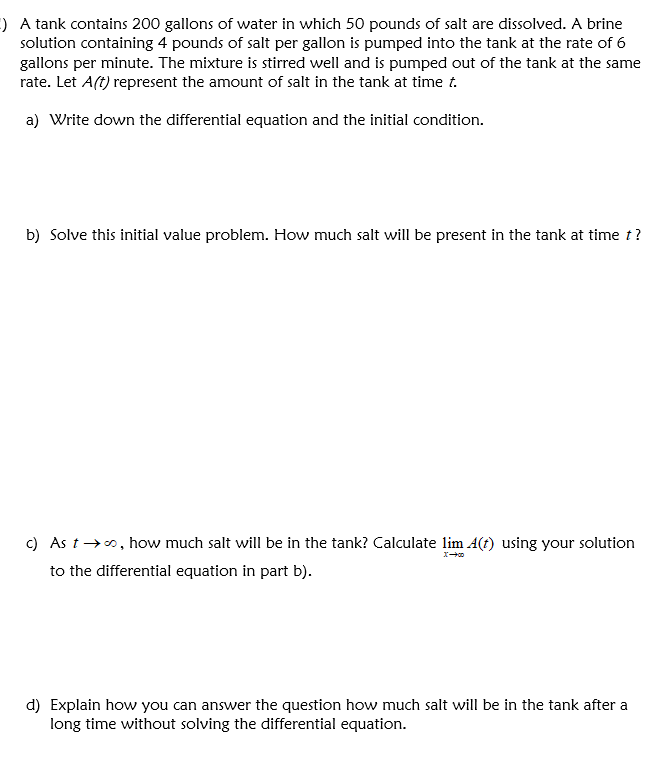) A tank contains 200 gallons of water in which 50 pounds of salt are dissolved. A brine solution containing 4 pounds of salt per gallon is pumped into the tank at the rate of 6 gallons per minute. The mixture is stirred well and is pumped out of the tank at the same rate. Let A(t) represent the amount of salt in the tank at time t. a) Write down the differential equation and the initial condition.
) A tank contains 200 gallons of water in which 50 pounds of salt are dissolved. A brine solution containing 4 pounds of salt per gallon is pumped into the tank at the rate of 6 gallons per minute. The mixture is stirred well and is pumped out of the tank at the same rate. Let A(t) represent the amount of salt in the tank at time t. a) Write down the differential equation and the initial condition.
Calculus: Early Transcendentals
8th Edition
ISBN:9781285741550
Author:James Stewart
Publisher:James Stewart
Chapter1: Functions And Models
Section: Chapter Questions
Problem 1RCC: (a) What is a function? What are its domain and range? (b) What is the graph of a function? (c) How...
Related questions
Question
please show all steps

Transcribed Image Text:) A tank contains 200 gallons of water in which 50 pounds of salt are dissolved. A brine
solution containing 4 pounds of salt per gallon is pumped into the tank at the rate of 6
gallons per minute. The mixture is stirred well and is pumped out of the tank at the same
rate. Let A(t) represent the amount of salt in the tank at time t.
a) Write down the differential equation and the initial condition.
b) Solve this initial value problem. How much salt will be present in the tank at time t?
c) As t→o, how much salt will be in the tank? Calculate lim A(t) using your solution
to the differential equation in part b).
d) Explain how you can answer the question how much salt will be in the tank after a
long time without solving the differential equation.
Expert Solution
This question has been solved!
Explore an expertly crafted, step-by-step solution for a thorough understanding of key concepts.
Step by step
Solved in 2 steps with 1 images

Knowledge Booster
Learn more about
Need a deep-dive on the concept behind this application? Look no further. Learn more about this topic, calculus and related others by exploring similar questions and additional content below.Recommended textbooks for you

Calculus: Early Transcendentals
Calculus
ISBN:
9781285741550
Author:
James Stewart
Publisher:
Cengage Learning

Thomas' Calculus (14th Edition)
Calculus
ISBN:
9780134438986
Author:
Joel R. Hass, Christopher E. Heil, Maurice D. Weir
Publisher:
PEARSON

Calculus: Early Transcendentals (3rd Edition)
Calculus
ISBN:
9780134763644
Author:
William L. Briggs, Lyle Cochran, Bernard Gillett, Eric Schulz
Publisher:
PEARSON

Calculus: Early Transcendentals
Calculus
ISBN:
9781285741550
Author:
James Stewart
Publisher:
Cengage Learning

Thomas' Calculus (14th Edition)
Calculus
ISBN:
9780134438986
Author:
Joel R. Hass, Christopher E. Heil, Maurice D. Weir
Publisher:
PEARSON

Calculus: Early Transcendentals (3rd Edition)
Calculus
ISBN:
9780134763644
Author:
William L. Briggs, Lyle Cochran, Bernard Gillett, Eric Schulz
Publisher:
PEARSON

Calculus: Early Transcendentals
Calculus
ISBN:
9781319050740
Author:
Jon Rogawski, Colin Adams, Robert Franzosa
Publisher:
W. H. Freeman


Calculus: Early Transcendental Functions
Calculus
ISBN:
9781337552516
Author:
Ron Larson, Bruce H. Edwards
Publisher:
Cengage Learning